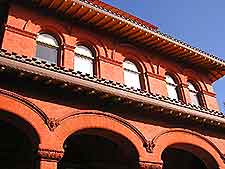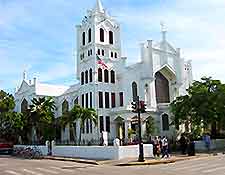Key West History Facts and Timeline
(Key West, Florida - FL, USA)

As the southernmost city of continental United States, Key West boasts an impressive history. The first pre-Columbian settlements on the island belonged to the indigenous people known as the Calusa, while the first European explorer to discover the island was Spanish explorer Juan Ponce de Leon in 1521.
With Florida coming under Spanish rule, a fishing village was established in Key West. It even fell briefly, along with the rest of Florida, under British rule. In any case, the name is believed to be an Anglicized version of Cueso Hueso, which means 'Bone Cay', although it is also the Western most Cay of this archipelago.
The Town's Founding
Although
Spain claimed Key West, no single nation exercised control over the island until 1822, when Lt. Commander Matthew C. Perry claimed it for the United States - but not before a crafty Spaniard officer, Juan Pablo Salas, who had been given the island, sold it twice! The first people to develop Key West were John Simonton, Pardon C. Greene, John Whitehead and John W.C. Fleming, whose names are still remembered as part of local history on avenues and buildings within the modern city.
Early Industry
Many Bahamians fled here during the 1830s and these people were commonly called Conchs (a term which is still used as a nickname for Key West locals today). Industries like fishing and salt production were big business in the 19th century.
By 1860, Key West had developed into one of the richest cities in the United States. Today's Old Town still preserves much history from this era. There are well-articulated tours of the city, or alternatively, you can visit the Museum of Art and History at the Customs House on Front Street.
During the 1800s, salvaging became one of the most important industries in Key West. At one stage, houses here were renowned for containing stunningly manufactured furniture, chandeliers and other expensive items salvaged from local shipwrecks. The city's Shipwreck Museum provides tourists with a detailed look at the influences of shipwrecks on the city.

Civil War and the Late 19th Century
The American Civil War (1861 to 1865) played a significant role in the development of Key West history. Fort Zachary Taylor, constructed between 1845 and 1866, was used by the Union Army despite Florida's joining of the Confederacy. The fort can still be explored today and now ranks as a State Historic Park. Of note, gun running earned a fortune for Key West at this time.
By 1889, cigar-making overtook salt and fishing industries as the major economic source. However, the city was relatively isolated until the Overseas Railway was constructed in 1912, which connected the island with the mainland. Following the railway's demise in a hurricane in 1935, the Overseas Highway was built in 1938, making it easier for tourists to access the Florida Keys. Even today it acts as a lifeline, putting Key West in touch with
Miami in a mere three and a half hours.
A Popular Winter Residence
Author Ernest Hemingway spent much of his life residing in his winter home in Key West. Several US Presidents also favored the city, especially, Harry S. Truman. The city became a popular destination for celebrities too, either to reside or holiday in, especially after the Overseas Highway was constructed. The Hemmingway House is available for tours, and visitors can even see a descendant of his famous 'seven-toed' cat, Snowball. The annual Hemingway look-alike competition is a highlight on the city's events calendar.
19th Century
The city experienced a large influx of Cuban immigrants from the late 1800s until the Cuban revolution of 1959, and most were employed primarily in the cigar-making industry. During WWII, the naval base at Fort Taylor was expanded, with the US Navy still having a major presence here today.
The city of Key West and its military bases played important roles during the Cuban Missile Crisis in 1962. In 1969, the first cruise ship docked here and today, cruise ships and tourism pull in some four million tourists annually.
 As the southernmost city of continental United States, Key West boasts an impressive history. The first pre-Columbian settlements on the island belonged to the indigenous people known as the Calusa, while the first European explorer to discover the island was Spanish explorer Juan Ponce de Leon in 1521.
As the southernmost city of continental United States, Key West boasts an impressive history. The first pre-Columbian settlements on the island belonged to the indigenous people known as the Calusa, while the first European explorer to discover the island was Spanish explorer Juan Ponce de Leon in 1521.